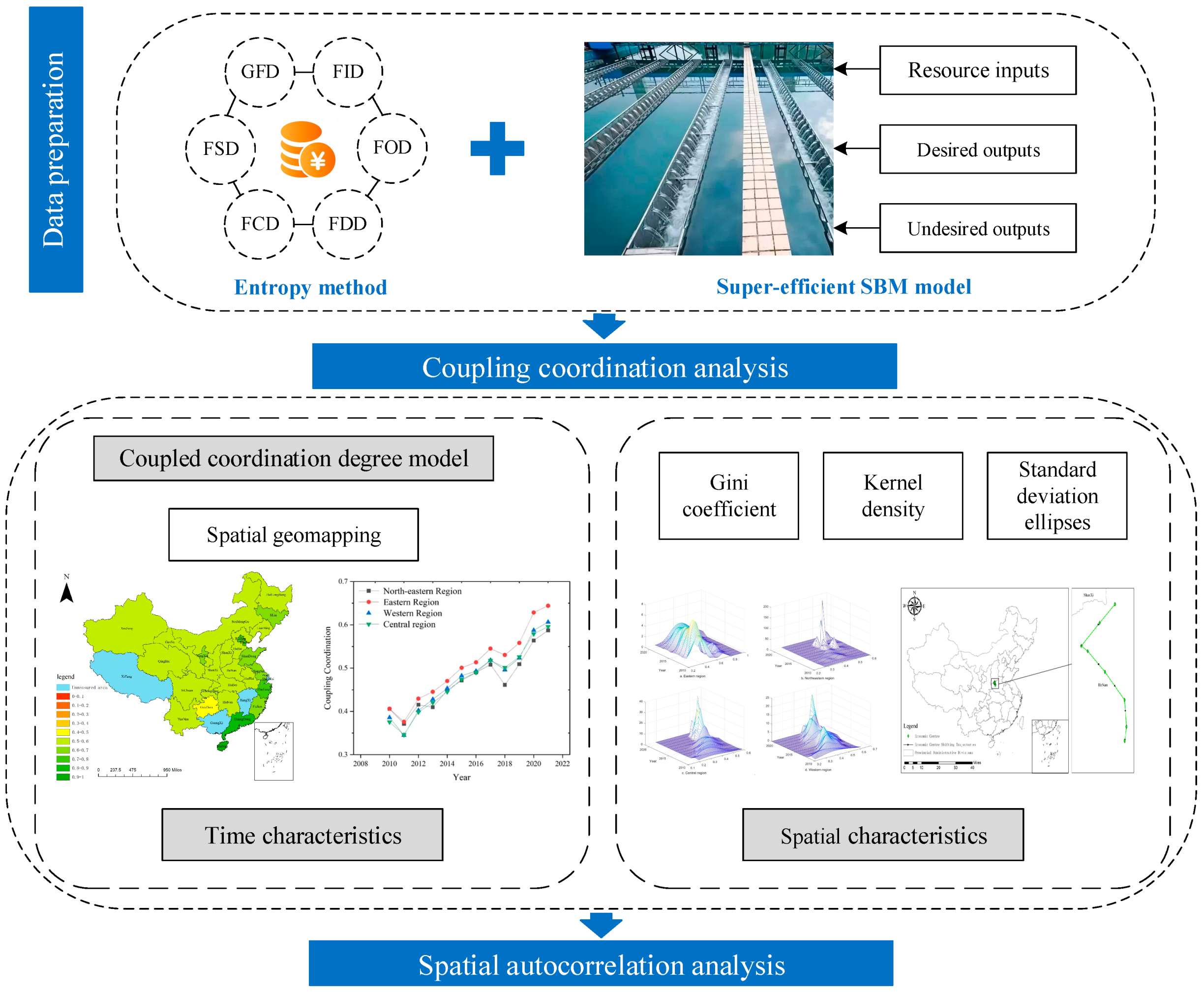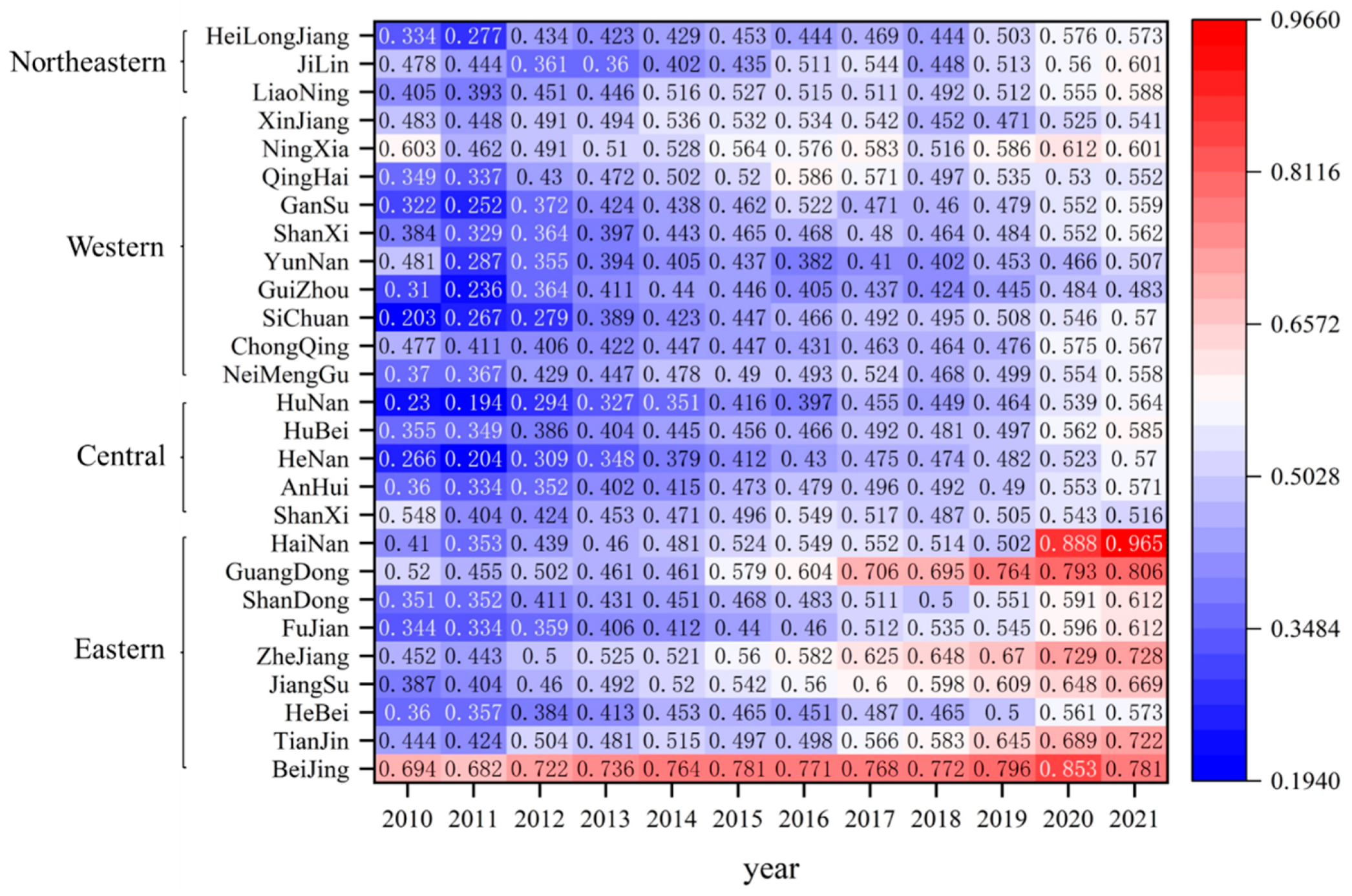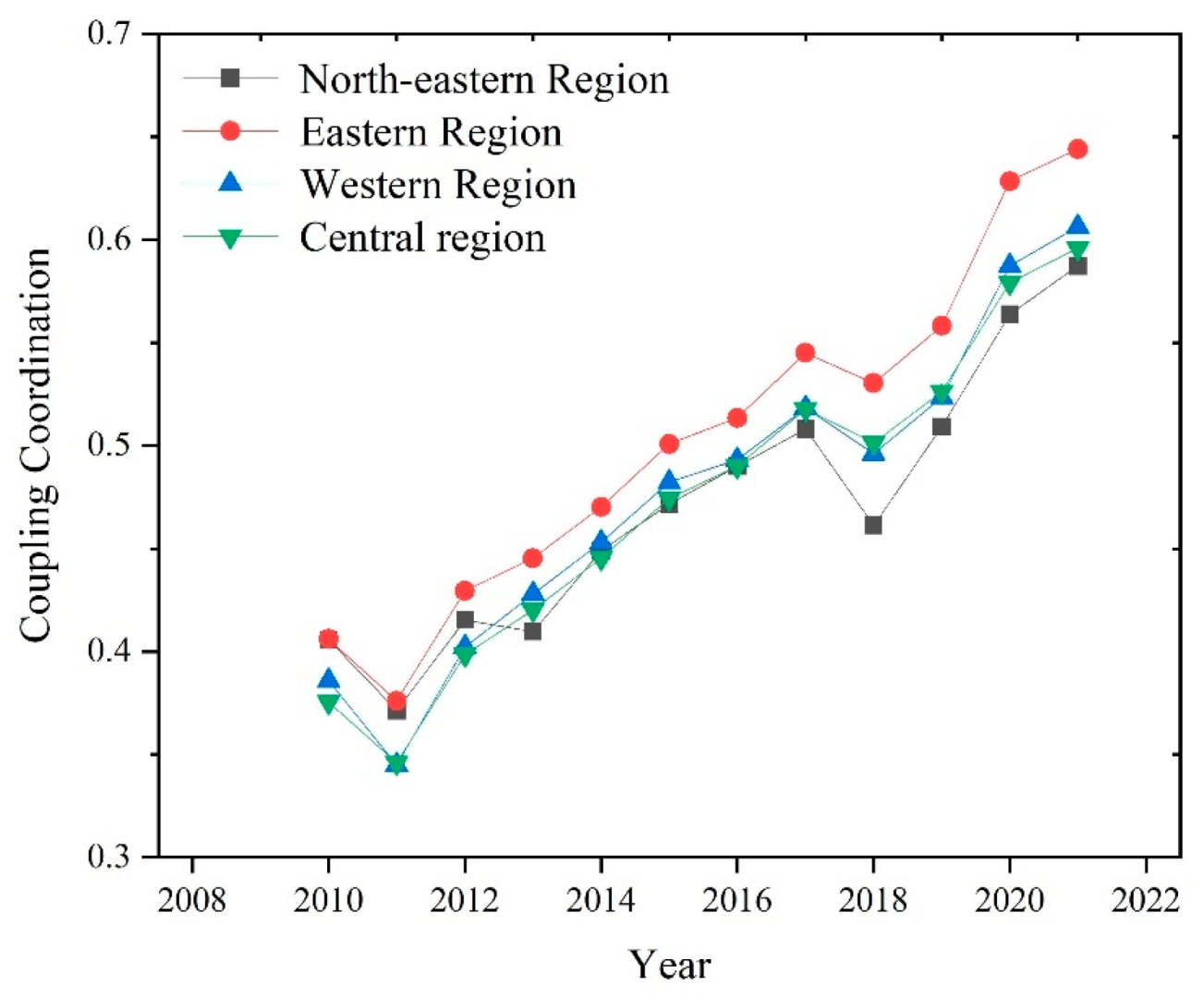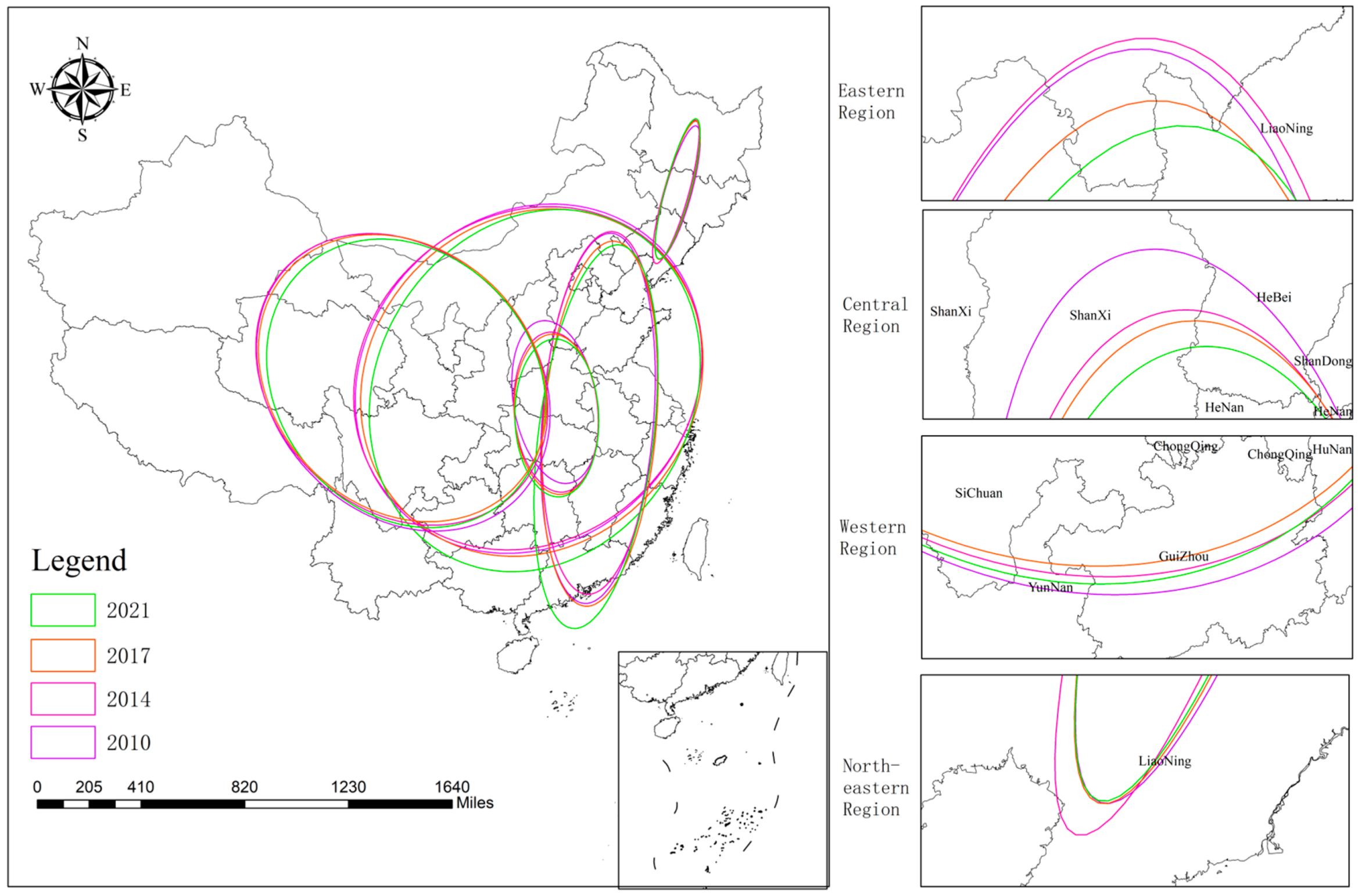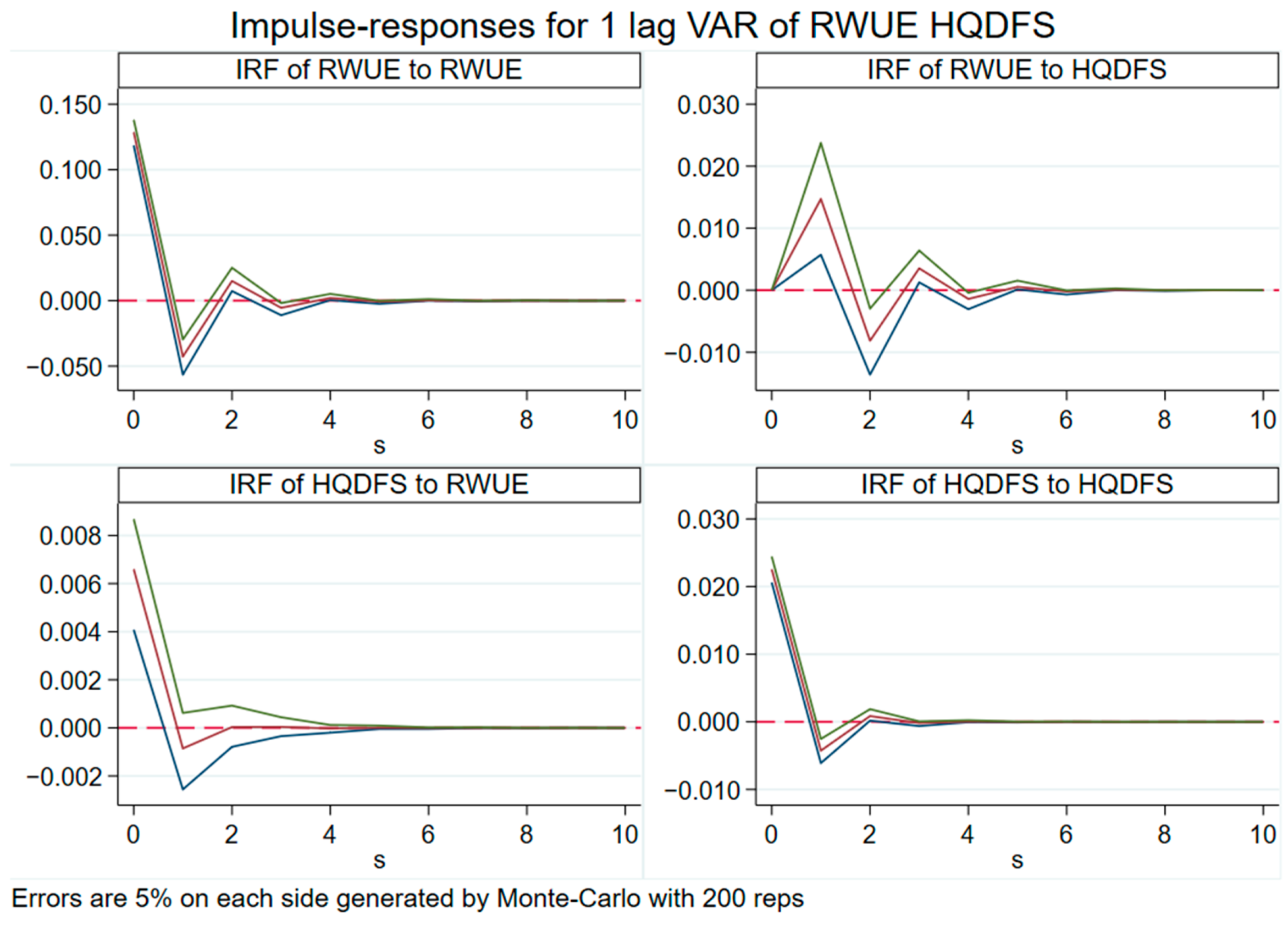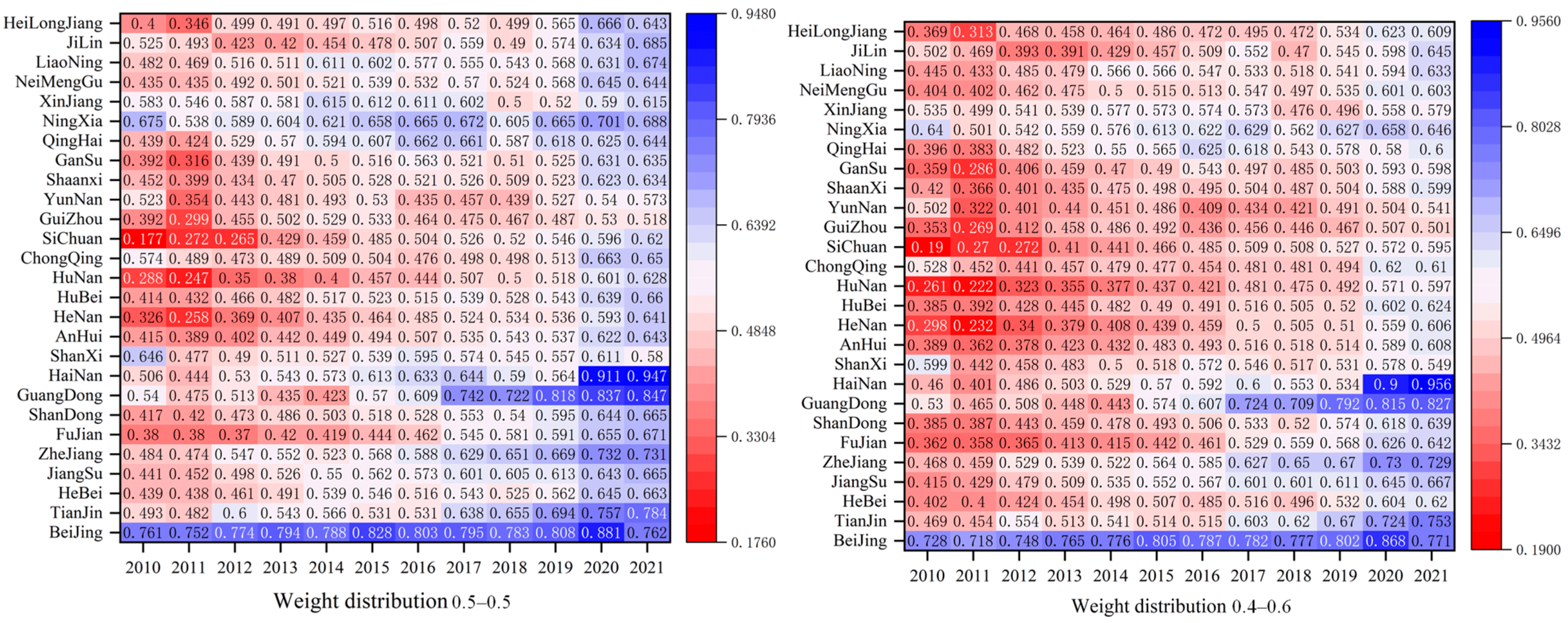1. Introduction
Nowadays, China attaches great importance to the role of the financial sector in helping to save water and pool resources. And, in 2024, the Ministry of Water Resources of the People’s Republic of China and the Bank of China jointly issued the ‘Guiding Opinions on Financial Support for the High-Quality Development of the Water Conservation Industry’, which states that the financial industry should focus on supporting the utilization of non-conventional water and providing integrated financial services. To broaden the financing channels of water conservation projects, we must actively explore various financial products and tools, such as bond issuance and underwriting, equity investment, financial leasing, investment consultants, etc. Combined with the above background, it is of practical significance to explore the extent to which the high-quality development level of the regional financial sector is coupled and coordinated with the use of reclaimed water [
1,
2]. Therefore, the reclaimed water industry still needs to address the challenges of funding, technology, and market mechanisms to achieve wider application and more efficient resource utilization [
3].
The financial industry needs to achieve the following goals in the process of high-quality development [
4]: above all, it should enhance the core competitiveness of the country, build a financial powerhouse, improve the capacity of financial services, and enhance the international competitiveness of China’s economic system [
5]. Subsidiarily, it is necessary to promote scientific and technological innovation and green development through deepening the development of scientific and technological finance and green finance, to guide financial resources towards scientific and technological innovation and green industries, and to promote the optimization and upgrading of the industrial structure to achieve sustainable development [
6]. The financial sector’s support for the green industry can lead to the development of the reclaimed water industry [
7]. Financial support enables wider reclaimed water applications in industrial production, municipal miscellaneous uses, and other areas, thereby increasing the demand for reclaimed water [
8]. Therefore, HQDFS can have a positive impact on RWUE; meanwhile, an increase in RWUE means more efficient and sustainable water management, which can help to reduce the risk of financial institutions investing in water-intensive industries, as water scarcity and water pollution are some of the main risks faced by these industries [
9,
10,
11,
12].
As summarized above, there is a significant coupling and coordination relationship between HQDFS and RWUE. On the one hand, the financial industry provides financial support for reclaimed water projects through green financial products and services, such as green credit, green bonds, etc., which promotes the construction of reclaimed water treatment facilities and technological upgrades [
13,
14]. On the other hand, an improvement in RWUE can reduce the operating costs of enterprises and improve their economic efficiency and market competitiveness, which, in turn, increases their demand for financial products and services and promotes the HQDFS of the financial industry. In addition, the improvement in RWUE can also reduce the dependence on traditional water resources, reduce environmental risks and enhance the stability of the financial system [
15,
16]. Therefore, the positive interaction between the financial industry and RWUE not only helps to achieve sustainable economic development but also promotes the stability and efficient operation of the financial market.
In the final analysis, the question of how to build HQDFS and RWUE in a balanced manner has gained importance recently [
17,
18]. The main research questions in this study are as follows: (1) What is the coupled coordination relationship between HQDFS and RWUE, meaning is it for quality coordination or on the verge of disorder? (2) What changes occur in the coupled and coordinated interaction between the two systems in terms of time and space? (3) What government policies are necessary to support the balanced growth of RWUE and HQDFS? Based on this, the CCD between HQDFS and RWUE is calculated and its temporal variation features are analyzed in this study using the coupling coordination model. Additionally, the CCR between HQDFS and RWUE is further investigated in this study using the PVAR model and spatial autocorrelation analysis. Finally, based on the results from this study, we offer sensible policy recommendations.
This study’s following portions are organized as follows: A review of the relevant literature is included in
Section 2. The methodology employed in this study is described in
Section 3 and consists mostly of the data sources, research techniques, and indicator system of RWUE and HQDFS. A detailed analysis of the empirical results is presented in
Section 4. This study’s conclusions are summarized in
Section 5 along with some insightful policy recommendations.
5. Conclusions and Policy Recommendations
5.1. Conclusions
Utilizing provincial panel data from China spanning the years 2010 to 2021, this study measures the CCD between RWUE and HQDFS. While the methodological limitations in this study do not allow us to explore how CCD is affected by other external factors, this study provides a comprehensive analysis of the temporal and spatial evolution characteristics of CCD. The conclusions of this study are as follows:
The CCD of RWUE and HQDFS shows a rising trend in general, and it has been upgraded from barely coordinated to primary coordinated evolution. The key breakthrough to intermediate and quality coordination grades is to improve the level of HQDFS. The eastern region demonstrates a marginally higher mean value of CCD than the western, central, and northeastern regions, achieving a primary coordination level by the end of the examination period. The eastern region should give full play to its demonstration effect, pulling the upgrading of CCD in the neighboring regions, strengthening inter-regional cooperation, and creating a mutually beneficial and complementary situation. Similarly, the western, central, and northeastern areas have also made progress, reaching the primary coordination level during the same timeframe.
The overall spatial variance of CCD shows a fluctuating downward trend. The core of solving the problem of uneven spatial distribution of CCD is to reduce the inter-regional difference, and the contribution of intra-regional difference and hypervariable density contribution to the spatial difference is relatively small. The largest intra- and inter-regional differences are found in the eastern and western regions. China should increase its financial investment in the western region, especially in infrastructure development, scientific and technological innovation, and ecological environmental protection, to address the problem of excessive inter-regional disparities. And the largest intra-regional differences are found in the eastern region. The eastern region should address the problem of polarization, i.e., the over-coordination of individual regional couplings and the wide gap with neighboring regions, by strengthening the circulation of talents and technical exchanges between provinces and cities and by disseminating successful experiences to reduce intra-regional disparities.
The distribution curve of the CCD from 2010 to 2021 shows an overall rightward shifting trend, with the height of the main peak rising and the width of the peak decreasing, indicating that the absolute difference in CCD has a tendency to decrease, and there is a dynamic convergence characteristic. The CCD between the eastern and northeastern regions showed an increase, yet there is a tendency for the absolute differences to widen, potentially indicating the emergence of a polarization phenomenon. Meanwhile, the central region has experienced a shift from a single peak to a double peak in its distribution, suggesting that polarization trends within the region have been intensifying. The standard deviation of CCD, elliptical in shape, approximates a positive circle and is predominantly situated in China’s eastern and central regions. It is gradually exhibiting a ‘northwest-southeast’ spatial distribution pattern.
The spatial autocorrelation between RWUE and HQDFS shows that the mechanism by which RWUE contributes to HQDFS is very pronounced in the first period, while at the same time, under a one-standard-deviation shock to HQDFS, RWUE exhibits a peak response in the current period, followed by a gradual decline, but exhibits favorable impacts for most of the period. Therefore, the facilitating effect of RWUE on HQDFS can be fully utilized, which not only promotes the simultaneous development of HQDFS but also improves the level of CCD between the two.
5.2. Policy Recommendations
To make the CCD of RWUE and HQDFS in China synergistically optimized across regions, and to accelerate the construction of a development system for RWUE, based on the above conclusions, the following policy recommendations are proposed:
The first focuses on improving the level of HQDFS and exploiting the potential for CCD between RWUE and HQDFS. Based on the conclusions of the above study, it can be seen that the key to achieving high-quality coordination between the two is to improve the level of HQDFS. In light of this, prioritizing HQDFS is essential for advancing the construction of reclaimed water systems. To initiate this process, it is imperative to bolster the financial sector’s infrastructure. Another is to improve the financial regulatory system. The last is to promote the deep integration of the financial sector and technology. Financial institutions should actively introduce and apply new technologies, such as artificial intelligence and blockchain, to improve the efficiency and quality of financial services.
The second is to remove regional heterogeneity and explore the path of constructing benign synergies between RWUE and HQDFS. From the findings of this study, it is clear that inter-regional differences are the main source of differences in CCD among the four major regions in China. Therefore, from the perspective of the four major regions, to focus on reducing interregional differences, we should start with the eastern and western regions, which have the greatest inter-regional differences, and promote the docking and development of the two major regions; the central and western regions should give fuller play to their comparative advantages, such as their resource advantages and location advantages, and promote industrial upgrading and rapid economic growth through policy guidance and market mechanisms.
The third is to actively build a spatially linked synergistic development pattern of RWUE and HQDFS. As can be seen from the empirical results, there is a spatial correlation between the RWUE and HQDFS in most provinces and neighboring provinces. Hence, to make effective use of positive interregional spatial spillovers, it is important to create special working groups to optimize the CCD patterns specific to each region, based on the changing trends and spatial differences in CCD development in the eastern, western, central, and northeastern regions. These working groups should focus on the characteristics of their regions to enhance the level of CCD development of their respective provinces in the future and to make efficient use of the results of high CCD development already achieved by neighboring provinces.
5.3. Limitations and Prospects
This study uses the coupling coordination degree model to investigate the relationship between RWUE and HQDFS and employs a series of models to verify the spatial and temporal characteristics of the coupling relationship between the two. However, the provincial research object was selected in the research scale, and the spatial scale is too large, which may affect the robustness of the conclusions of this study. Further, only the influence effect between the two systems was considered, failing to take into account the influence effect of other external factors on this coupling degree. Therefore, in the future, the research object can be set to the city scale to consider the influence of policy regulation, economic environment technological innovation, and other factors on the degree of coordination of the two couplings, to provide a richer and more detailed empirical value for the coordinated development of reclaimed water and the financial industry.

